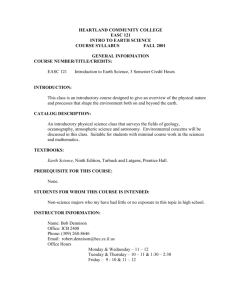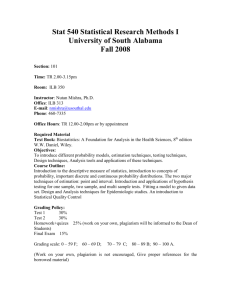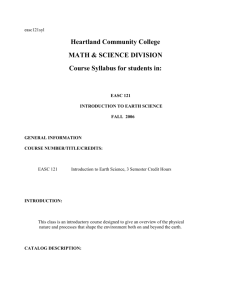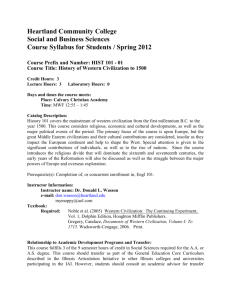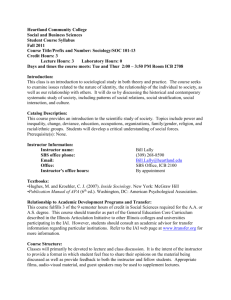EASC 111 - Bob Dennison - Heartland Community College
advertisement
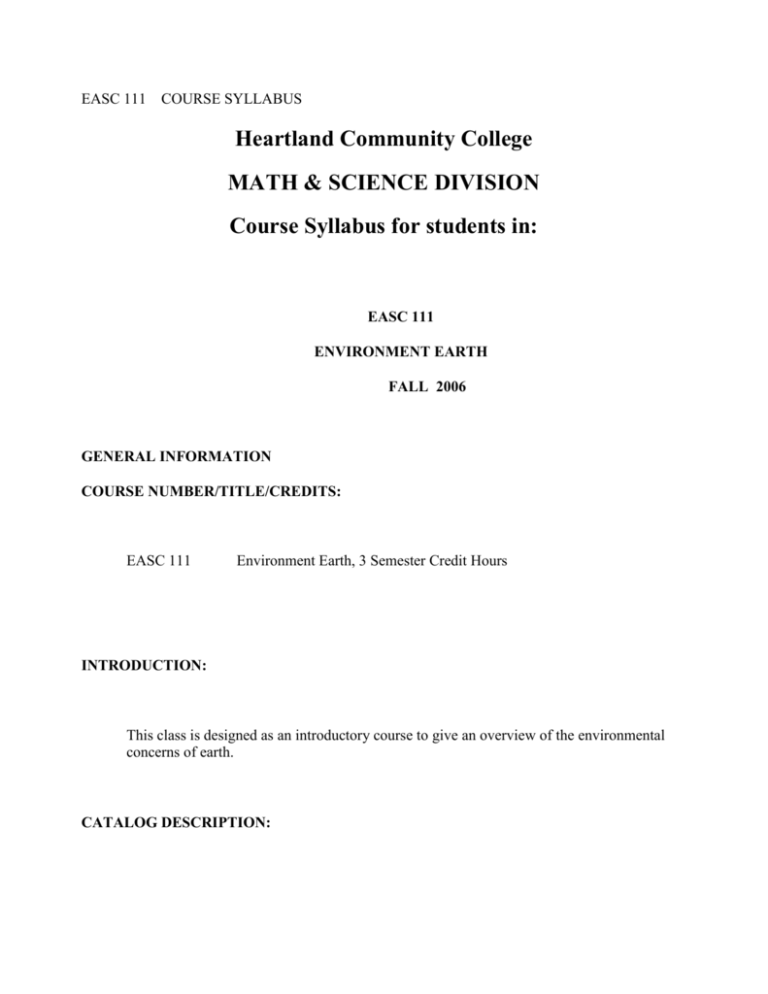
EASC 111 COURSE SYLLABUS Heartland Community College MATH & SCIENCE DIVISION Course Syllabus for students in: EASC 111 ENVIRONMENT EARTH FALL 2006 GENERAL INFORMATION COURSE NUMBER/TITLE/CREDITS: EASC 111 Environment Earth, 3 Semester Credit Hours INTRODUCTION: This class is designed as an introductory course to give an overview of the environmental concerns of earth. CATALOG DESCRIPTION: Topics course for non-science majors who desire a physical science understanding of environmental concerns. Topics may include ground water, air quality, land management, nuclear energy, and solid waste disposal. TEXTBOOK: Environmental Science, Tenth Edition, Enger and Smith, McGraw-Hill, 2006. PREREQUISITE FOR THIS COURSE: None. STUDENTS FOR WHOM THIS COURSE IS INTENDED: Non-science majors who my have had little or no exposure to science in high school. INSTRUCTOR INFORMATION: Name: Bob Dennison Office: ICB 2408 Phone: (309) 268-8646 Email: robert.dennison@heartland.edu Office Hours: Monday/Wednesday/Thursday/Friday from 10-11 Tuesday from 12 -1 COURSE PURPOSE GENERAL COURSE GOALS & LEARNING OUTCOMES: 1. 2. 3. 4. 5. 6. 7. 8. 9. 10. 11. 12. 13. 14. 15. 16. Understanding of the scientific method by observing. gathering, and evaluating information. Develop an ability to use science as a tool for understanding the natural world Recognize environmental science as an integration of life, physical, and social scie nce Understand basic ecological principles Prepare written reports and evaluations. Distinguish between biotic and abiotic factors in an ecosystem Describe and apply the principle of sustainability Describe environment and resources in terms of economic and non-economic value. Demonstrate an awareness of local, national, and global environmental issues. Discuss perspectives on the severity of disruptions of the integrity of ecosystems Identify the impacts of humans on the environment. Classify unwanted results of resource use including depletion, waste, and pollution. Describe the demographic transition model. Give examples of unsustainable use of resources. Describe the positive and negative aspects of food production for human use. Describe processes by which humans can protect the environment, including politically. Communication Learning CODE STATEMENT QUALITIES CO1 Students compose a message and provide ideas and information suitable to the topic, purpose, and audience. Students create a message using various structures, claims, support, credibility, etc., depending upon their topic, purpose, and audience CO2 Students effectively Students prepare Outcomes OUTCOME # METHOD 5 Group project, Position deliver a message written, oral, visual, via various and/or experiential channels/modalities. materials for an area of study. CO3 Students listen in order to comprehend information, critique and evaluate a message, show empathy for the feelings expressed by others, and/or appreciate a performance. Students determine what is expected of them as listeners in an interaction and respond appropriately. CO4 Students are selfreflective of the communication process. Students objectively analyze their own communication and modify it when necessary. CO5 Students communicate ethically through monitoring their behavior and interactions with others. Students recognize the meanings and values associated with their communication and take these into account during the communication process CO6 Students can recognize and negotiate differences. Students develop and use appropriate conflict management strategies. papers, video quizzes Diversity Learning Outcomes CODE DI 1 DI 2 DOMAIN LEVEL STATEMENT OUTCOME # METHOD Receiving Students are receptive to beliefs and values that differ from their own. Various Lecture, Exam, Environmental Club Project Responding Students consider the views of others in light of those persons’ experiences and particular understandings DI 3 DI 4 DI 5 Valuing Students reflect upon the formation of their own perspectives, beliefs, opinions, attitudes, ideals, and values. Organizing Students explain the contributions of diverse perspectives to the development of various fields of inquiry and to society as a whole, and re-examine their own values and beliefs in light of the insights they have gained from their study of other cultures. Characterizing Students consistently and characteristically approach diversity issues in a manner that exemplifies respect for and appreciation of difference. 16 Exams, lectures, quizzes Problem-Solving Learning Outcomes CODE STATEMENT QUALITIES OUTCOME # METHOD PS 1 Student can solve problems based on examples and frameworks provided by instructor. Student can only solve problems that they are shown first. Student sees answers as only being right or wrong. Student is highly dependent on the instructor. 1 Lecture, written exam PS 2 Student identifies the type of problem and use a framework to solve the Student can solve problems different from those shown. Student 2 recognizes where the process broke down Lecture, written exam problem. when incorrect answers result. PS 3 Student identifies the type of problem and, from multiple problem solving methods, chooses the best method and solves problem. Student tries to apply multiple strategies to solve problems. Student shows ability to solve problems which have not been previously demonstrated by the instructor. Student is not as dependent on the instructor PS 4 Student analyzes the situation, explores different outcomes from multiple frameworks, applies the appropriate solution, analyzes the results, and refines the solution. Student sees problem solving as a process and is not satisfied with first answer to problem reviews answers for validity. Student transfers problem solving ability across the disciplines. PS 5 Student has the ability to define, interpret, and solve problems through collaboration with others. Student has the ability to consult with students from other disciplines to solve problems in all situations. Student perseveres until solution is found. Critical Thinking Learning Outcomes CODE STATEMENT QUALITIES OUTCOME # CT 1 Students gather knowledge, apply it to a new situation, and draw reasonable conclusions in ways that demonstrate Students inquire into an unfamiliar situation 2, 6, 8, 10, 11, given a strategy or 13, 14, 15 concept. (Responding in a similar situation) METHOD Lectures, exams, pop quizzes, video quizzes, small group discussion, group project comprehension. CT 2 Students determine value of multiple sources or strategies and select those most appropriate in a given context. Students compare various perspectives, strategies or concepts and respond using the most appropriate alternative. (Making a decision) CT 3 Students generate an answer, approach, or solution through an effective synthesis of diverse sources and arguments and provide a rationale. Students use creative thinking to produce a product, idea, or 12 method that is new to them. (Designing your own) CT 4 Students actively reflect on their answer, approach, or solution and act upon those reflections to improve the final result. Students justify, challenge, and revise their position, judgment, or conclusion through self-assessment and active reflection. (Reflecting upon one’s own thought process) 7, 9 Lectures, exams, pop quizzes, video quizzes, small group discussion, group project Group project RELATIONSHIP OF COURSE TO STUDENT ACADEMIC DEVELOPMENT EASC 111 provides a basic scientific foundation necessary for further college-level courses. RELATIONSHIP OF COURSE TO GENERAL EDUCATIONAL REQUIREMENTS This class will fulfill lab science credit in the A. A. and A. S. degree requirements. EDUCATIONAL BELIEFS: BELIEFS ABOUT STUDENT LEARNING: Students must take an active role in the learning process for it to take place and for you to feel a sense of accomplishment. Desire, effort, and persistence are the key ingredients to your success. BELIEFS ABOUT TEACHER’S ROLE: I will be responsible for creating an atmosphere conducive to the learning process. Please feel free to ask me questions either during your class period or my office hours or whenever we can make a connection. DESCRIPTION OF INSTRUCTIONAL TECHNIQUES AND RATIONALE: Lecture discussion, tests, quizzes, and written reports. Students will have the opportunity to ask questions and contribute throughout. DESCRIPTION OF LEARNING FORMAT: Students will be able to achieve success by: 1. 2. 3. 4. 5. 6. Attending class regularly and taking all the exams. Participating in discussions and group work. Asking questions about material you do not understand. Doing careful, thoughtful and thorough work. Reading the assigned material before class lecture and again afterwards. Taking good notes and reviewing them regularly. 7. 8. 9. 10. Reviewing the key terms and questions at the end of each chapter. Reviewing the material listed on your test review sheets. Forming a study group with other members of this class. Attending class on time. FEEDBACK AND GRADING GRADING SYSTEM/METHOD OF EVALUATION: Scale: A > 90%, B = 80-89%, C = 70-79%, D =60-69%, F<60% based upon percentage of total points. There will be a total of five exams [four exams over lecture material and a final exam]. The lecture exams are worth 100 points each and consist of 50 multiple choice questions. Any make-up exams will consist of 20+ essay questions with a 45 minute time limit to complete the questions. You must notify me before your test is scheduled by phone [268-8646] or you will not be able to take the make-up exam. Makeup tests must be completed in a timely manner as determined by your instructor. Make-up exams are only worth a maximum of 95% of the original test. Failure to do so will result in a score of ZERO for that exam. The remainder of your grade will consist of a 100 point group project in which you will be graded both as a group and individually, quizzes, writing assignments, and attendance. Attendance points will be granted not only by your attendance but also by your participation in class lectures. Everyone must take the final exam during its scheduled time. All grading issues are left to the discretion of the instructor including allowing makeup exams for missed tests. HEARTLAND'S GRADING PHILOSOPHY Letter Grade Rubrics A (4.0) This grade represents consistently outstanding performance that demonstrates superior understanding and skillful use of important course concepts. Performance at this level signifies that the student is extremely well prepared to continue with more advanced study of the subject. B (3.0) This grade represents performance significantly beyond the level necessary to achieve the course objectives. Work is of high quality but not consistently at an outstanding level. Performance at this level signifies that the student is well prepared to continue with more advanced study of the subject. C (2.0) This grade represents an acceptable achievement of the course objectives. Performance at this level signifies that the student is reasonably well prepared to continue with more advanced study of the subject. D (1.0) This grade represents less than adequate performance. It signifies questionable readiness to proceed with more advanced study of the subject. F (0.0) This grade reflects unacceptable performance. The student is not yet ready to proceed with more advanced study of the subject, and must repeat the course successfully to receive credit. Philosophy of Grades The Heartland Community College grading philosophy grows out of our vision of educational excellence. This common philosophy provides a framework for each academic division and instructor as they establish their own individual course grading system, evaluation methods, and course policies using the shared general rubrics for letter grades given below. Letter grades serve as a vehicle to promote meaningful evaluation of student achievement, to inform students of academic progress, and, as necessary, to improve student performance, habits, and practices. Using a letter grade as a prerequisite for subsequent courses means we believe that the grade was assigned through a conscious judgment about a student's readiness to proceed to more advanced study. At Heartland, students' academic achievement is measured by their mastery of course objectives and content. We challenge students to meet these recognized standards of achievement and we assign grades based on their success in doing so. Simply stated, we believe that the responsibility for academic achievement rests with the student and that holding students responsible for their learning promotes their academic growth. POLICIES ON ASSIGNMENTS/TESTS/MAKE-UPS: Makeup exams will only be granted in unusual circumstances. Students are expected to show up and take their tests when scheduled by the instructor. Students must notify the instructor BEFORE their scheduled test begins by phone [268-8646] in order to be allowed an opportunity for a makeup exam. Students must make arrangements with the instructor no later than 24 hours after the test is given to set aside a time for their makeup exam. Failure to do so will result in a score of ZERO for that exam. Students are expected to turn in their assigned work on time. No exceptions will be granted for late assignments. Assignments are due per the instructor’s direction. POLICIES ON ATTENDANCE: Regular class attendance and coming on time is an important part of educational success and is expected of all students. No make up quizzes will be given. You are responsible for the information presented in each class for the exams. Students will be dropped for excessive missing of class at the instructor's discretion. ACADEMIC INTEGRITY Academic integrity is a fundamental principle of collegial life at Heartland Community College and is essential to the credibility of the College’s educational programs. Moreover, because grading may be competitive, students who misrepresent their academic work violate the right of their fellow students. The College, therefore, views any act of academic dishonest as a serious offense requiring disciplinary measures, including course failure, suspension, and even expulsion from the College. In addition, an act of academic dishonesty may have unforeseen effects far beyond any officially imposed penalties. Violations of academic integrity include, but are not limited to cheating, aiding or suborning cheating or other acts of academic dishonesty, plagiarism, misrepresentation of data, falsification of academic records or documents and unauthorized access to computerized academic or administrative records or systems. Definitions of these violations may be found in the college catalog. Plagiarism Plagiarism is the presenting of others’ ideas as if they were your own. When you write a paper, create a project, do a presentation or create anything original, it is assumed that all the work, except for that which is attributed to another author or creator, is your own. Plagiarism is considered a serious academic offense and may take the following forms: Copying word-for-word from another source and not giving that source credit. Paraphrasing the work of another and not giving that source credit. Adopting a particularly apt phrase as your own. Using an image or a copy of an image without crediting its source. Paraphrasing someone else’s line of thinking in the development of a topic as if it were your own. Receiving excessive help from a friend or elsewhere, or using another project as if it were your own. [Adapted from the Modern Language Association’s MLA Handbook for Writers of Research Papers. New York: MLA, 1995: 26] Note that word-for-word copying is not the only form of plagiarism. The penalties for plagiarism may be severe, ranging from failure on the particular piece of work, failure in the course or expulsion from school in extreme cases. Many plagiarism problems can be remedied by citing the sources of the original work. When in doubt, cite the source according to the style your instructor directs. Usually this is APA or MLA Style. Don’t be daunted by citing sources which are not books. You can cite everything – including pamphlets, maps, cereal boxes, telephone conversations, movies, television shows, Internet and world-wide web sites. Most cases of plagiarism arise from carelessness or haste. Violators often attempt to excuse themselves by saying that they were not told of the nature of plagiarism. You have been told. You must not include either the phrases or ideas of another writer in your papers without acknowledgment. Otherwise, you are stealing. Plagiarism is dishonest. It is cheating and is subject to severe penalties. It may endanger your whole career. Don’t do it. SUPPORT SERVICES Heartland Library Information http://www.heartland.edu/library The Library, located in the Students Commons Buildings at the Raab Road campus, provides Heartland students with a full range of resources including books, online journal databases, videos, newspapers, periodicals, reserves, and interlibrary loan. Librarians are available to assist in locating information. For more information please call the Library (309) 268-8200 or (309) 268-8292 Tutoring Center Heartland Community College offers tutoring in various forms at not cost to Heartland students at the Academic Support Center (ASC) in Normal and at the Pontiac and Lincoln Centers. Tutors are available at convenient times throughout the week. Study groups, group tutoring facilitated by a specially-trained tutor, are also available by request. For more information about services available at each location, please call the ASC in Normal (309) 268-8231; the Pontiac Center (815) 842-6777; the Lincoln Center (217) 735-1731. Testing Center The Testing Center provides a quiet environment for students to complete make-up exams, online exams, and exams for students with special accommodations. Students may be able to complete exams in the Testing Center if arrangements are made with their instructor. For more information, contact the Testing Center at (309) 268-8231. Open Computing Lab http://www.heartland.edu/asc/computerlab.html The Open Computing Lab provides free computing for HCC students at convenient times throughout the week. The computer lab is staffed by trained Lab Assistants and offers the use of approximately 70 computers, a scanner, a laser printer, and an electric typewriter. If you have a documented disability and wish to discuss academic accommodations, please contact: Anita Moore at 268-8249 or anita.moore@heartland.edu. CURRICULAR AND TRANSFER STATUS DEGREE/CERTIFICATE: This course counts toward completion of the A. A. Degree or the A. S. Degree. TRANSFERABILITY: Check with an advisor to get specific transfer information related to the school you wish to attend. STUDENT ASSIGNMENTS AND PURPOSE RELATIONSHIP OF COURSE GOALS TO ASSIGNMENTS: Each assignment provides background needed to achieve course goals. RATIONALE FOR COURSE CONTENT: Course content covers science fundamentals and basic techniques necessary for more advanced science courses. Topics in the class will increase earth-environment awareness. WHAT STUDENTS NEED TO BRING TO EACH LAB MEETING: 1. 2. 3. 4. 5. 6. Pencil and/or pen Calculator Textbook Notebook Highlighter If you bring a cell phone, make certain it is turned OFF during class. CALENDAR & ASSIGNMENTS ASSIGNMENTS TEST ONE MATERIAL Introduction to Earth Science Chapter 1 – Environmental Interrelationships Chapter 2 - Environmental Ethics Chapter 3 - Risk and Cost: Elements of Decision Making Test One - approximately week 4 of the semester TEST TWO MATERIAL Chapter 5 – Interactions: Environments and Organisms Chapter 6 – Kinds of Ecosystems and Communities Chapter 7 – Population Principles Chapter 8 - Human Population Issues Test Two- approximately Week 8 of the semester TEST THREE MATERIAL Chapter 9 – Energy and Civilization: Patterns of Consumption Chapter 10 - Energy Sources Chapter 12 - Biodiversity Issues Chapter 15 –Agricultural Methods and Pest Management Test Three - approximately Week 12 of the semester TEST FOUR MATERIALS Chapter 16 – Water Management Chapter 17 – Air Quality Issues Chapter 20 – Environmental Policy and Decision Making Test Four - approximately week 15 of the semester TEST FIVE MATERIALS [FINAL EXAM] A comprehensive final taken from all the material above. See schedule below for dates and times of your final exams. DATES FOR EXAMS/QUIZZES: You will be informed at least one week in advance of the tests. Quizzes can occur with or without prior notice. You will also be notified in class of the time allowed for assignments to be completed. In most cases you will have one week to turn in written assignments. FINAL EXAM SCHEDULE EASC 111 – 01, will have a final on Wednesday, December 13th from 8:00 -9:50 EASC 111 - 03, will have a final on Tuesday, December 12th from 11- 12:50 EASC 111 – 04, will have a final on Monday, December 11th from 12:00 - 1:50 EASC 111 - 05, will have a final on Wednesday, December 13th from 2:00 - 3:50 CLASS CANCELLATION ON INTERNET Notice of Canceled Class Sessions Cancelled class sessions, for all HCC classes, will be listed under Cancelled Class Meetings in the A-Z Index and under Academic Information in the Current Students page on the HCC Web site. Go to http://www.heartland.edu/classCancellations/ to learn what classes have been cancelled for that day and the upcoming week. Be sure to check the last column, which might contain a message from the instructor. WITHDRAWAL DATES Students are responsible for officially dropping/withdrawing in writing to Student Services/Registration from a course for which they have enrolled. Drop/Withdrawal requests made by telephone will not be accepted. Last date to withdraw: Regular semester: November 8th HOME BACK TO EASC111
